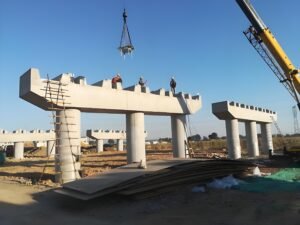
Have you ever driven across a bridge and marveled at its engineering marvel? While the majestic arches or sleek suspension cables grab most of the attention, there’s a hidden hero working tirelessly beneath the surface: the bridge bearing.
What Exactly is a Bridge Bearing?
Imagine a bridge as a giant, constantly shifting structure. Traffic, wind, and temperature changes all cause the bridge to move subtly. Bridge bearings are the unsung heroes that sit between the bridge deck and its supporting structures, allowing for this controlled movement. These specialized components absorb and transfer loads, ensuring the bridge remains stable and functions smoothly.
Different Types of Bridge Bearings for Different Needs
Just like bridges come in various designs, bridge bearings too, have diverse functionalities. Here are some common types:
- Elastomeric Bearings: These are flexible pads made of rubber or similar materials. They offer excellent vibration damping and are ideal for accommodating small movements.
- Pot Bearings: These bearings utilize a cylindrical steel pot filled with a fluid or elastomer. They provide excellent movement in all directions and are commonly used for large bridges.
- Disc Bearings: These robust bearings consist of steel discs separated by a low-friction material. They handle high loads and are suitable for fixed or simply supported bridges.
Beyond Support: 3 Key Features of Bridge Bearings
Bridge bearings are vital not just for initial bridge stability, but also for its long-term health. They offer several key features that contribute to a bridge’s overall performance:
- Accommodating Movement: As mentioned earlier, bearings allow for controlled movement of the bridge deck. This flexibility protects the bridge structure from stresses caused by thermal expansion, seismic activity, and settling of the foundation.
- Load Transfer: Bearings efficiently transfer the weight of the bridge deck, traffic, and other loads to the substructure (piers or abutments) below. This ensures the bridge remains structurally sound and distributes weight evenly.
- Vibration Damping: Certain types of bearings, particularly elastomeric bearings, excel at dampening vibrations caused by traffic or wind. This improves ride quality and reduces wear on the bridge deck and other components.
The Importance of Quality Bridge Bearings
The quality and performance of bridge bearings directly impact the bridge’s lifespan and safety. Reputable manufacturers like VSL employ cutting-edge technology and rigorous testing to ensure their bearings meet the highest standards.
Conclusion
Next time you cross a bridge, take a moment to appreciate the silent workhorses beneath your feet – the bridge bearings. These crucial components ensure a smooth, safe journey for everyone.sharemore_vert



